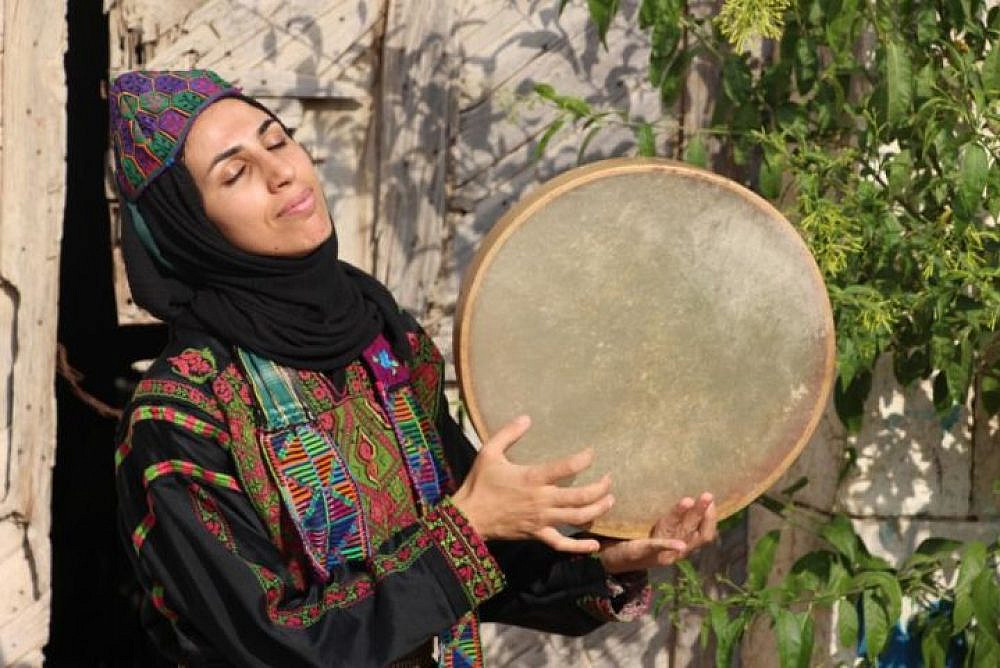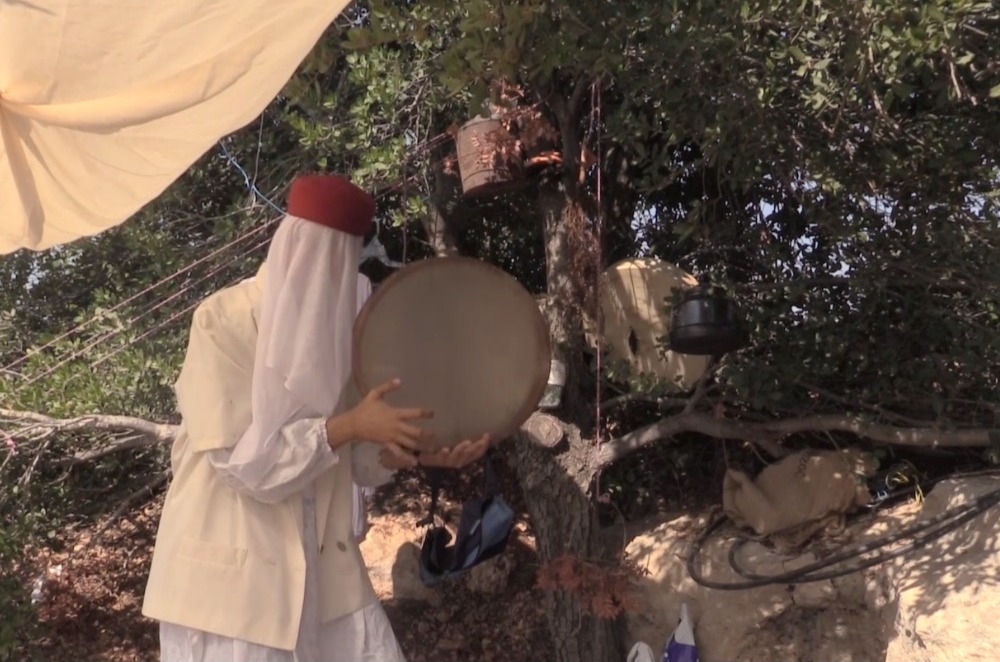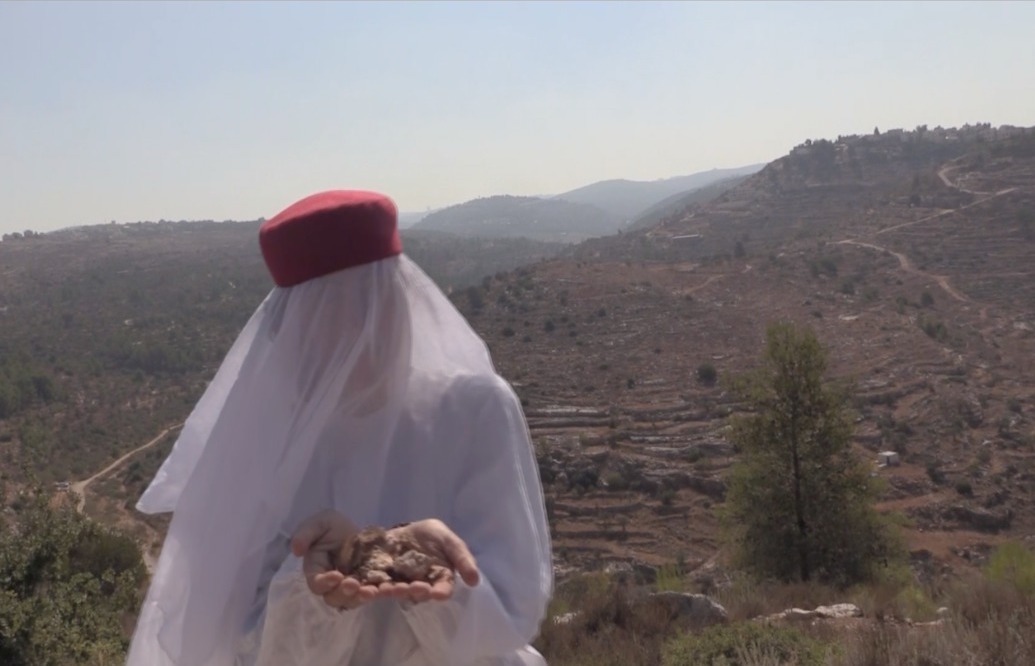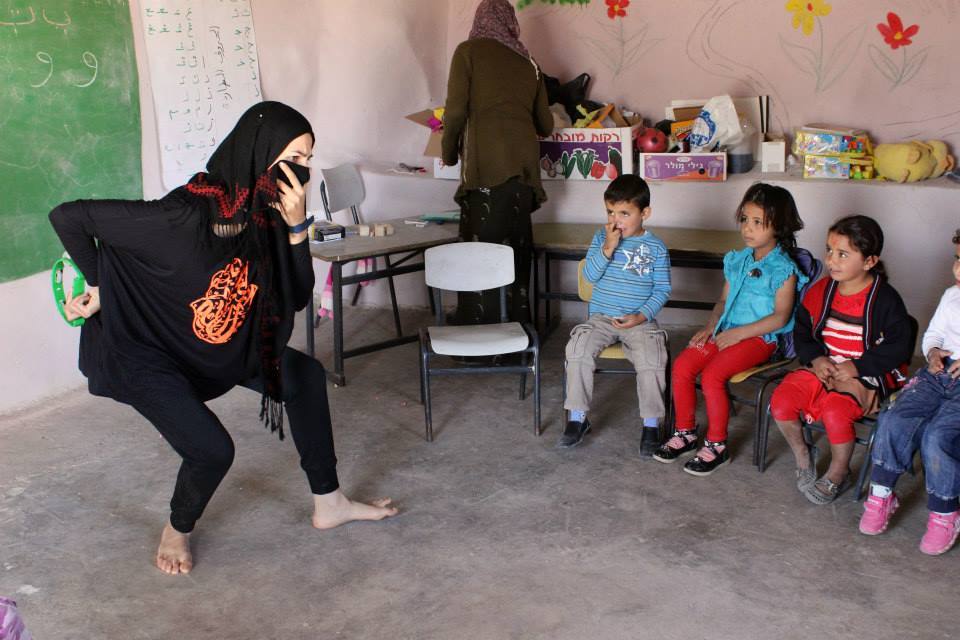‘The occupation is trying to uproot us. Art can bring us back’
Fida'a Ataya, a Palestinian storyteller based in the occupied West Bank, uses art as a means of resisting the Israeli settlers and military who have taken over the landscape of her childhood.
Fida’a Ataya, an artist from a village outside Ramallah in the occupied West Bank, is a hakawatia — a storyteller — who is well-acquainted with the dangers of trying to create art under occupation. Settlers have attacked her, broken her equipment, and wrecked what she’s tried to build on the hill of Kafr Ni’ma, where she was born in 1987, during the First Intifada.
But Ataya isn’t giving up. At the end of the month she’s organizing a festival called Al-Haya Al-Mahdoura (Forbidden Life), with artists from Palestine and abroad. “I want to bring the area back to life,” she says. “The Israeli occupation is trying to break our emotional connection to the land and uproot us. Art can bring us back.”
When she was a little girl, Ataya would frequent the hill that overlooks Kafr Ni’ma, which spans Areas B and C of the West Bank (under partial and complete Israeli control, respectively), and which itself is surrounded by other hills. Now, Ataya has turned her art into a means of resisting the military and the settlers that have taken control of that mountain.
‘The top of the world’
After studying cultural psychology in Ramallah and drama in Jarash, Jordan, Ataya went to study theatre in Lebanon. In 2018, she moved to the United States, where she received another degree in community art. At the end of 2020, however, the coronavirus pandemic forced her to return to Kafr Ni’ma from the United States.
Even before she went abroad to study, one of Ataya’s hobbies was taking daily hikes through the hills around her village. Al-Rusan Hill, which is part of Kafr Ni’ma’s land, was one of her favorite spots, and ever since she was a child, she would climb to its summit and sit there under a large tree.
“For me that was the top of the world,” Ataya recalls, “I felt like I was at the center of the world, surrounded by clouds, the sky stretching across the horizon with nothing obscuring its view, as if you were standing at the beginning and the end of the earth at the same time.
“I have to travel a lot for work, and I’ve seen a lot of nature, but for me, this is the most beautiful place in the world. This is where life begins.”
A settler at the top of Al-Rusan hill
Before she went to the United States, Ataya invited colleagues from Canada, the United Kingdom, and the United States to come and see the hills. They hiked there and wandered through the ruins of an ancient village, probably from the time of the Byzantine Empire. They found caves, fossils, and bits of pottery. One of her friends photographed the site, and they decided that their next art project would be on Al-Rusan Hill.
When she returned from the United States in 2020, Ataya went into quarantine because of the pandemic. “We have a small house close to the hill,” Ataya says. “I isolated myself there, and my parents brought me food.” One morning she went out on a hike toward the hill, as had been her routine. “I saw that there was a barbed wire fence,” she says, “and I kept walking. I saw a gate and a car going in. I went in right behind the car.”
She was told that an Israeli settler had taken over the hill. “I went up the hill and sure enough I saw a settler there in a mobile home,” Ataya recalls. “Everyone said he would probably leave.” In the village she heard that this same settler had paved a road from the neighboring village of Ras Karkar, all the way to the top of the hill, and set up a mobile home despite the objections of the Palestinian residents.
“When I arrived [in the village] there was a demonstration,” explains Ataya. “I didn’t participate in the demonstration, just continued up the hill. The soldiers stopped me on the way, threatened me with their guns and asked me what I was doing there and where I was going. They said it was a closed military zone and they wouldn’t let me go up the hill.”
“A settler saw me and asked me where I’m from. I replied that I’m a Palestinian-Italian. I entered the area. I saw someone feeding sheep. [The settlers] had turned the hill into a settlement. There were several mobile homes, a wood house, and big barns where they were raising animals – horses, goats, sheep. I saw a woman leaving her house. I tried to speak with her, but she ignored me.
“I continued to walk towards the tree where I used to sit. They had changed everything. Not a trace of the Byzantine village remained. Someone came over and started interrogating me. I spoke to him in English. He had a gun. He was the head of the hilltop settlement.
“He barely understood what I was saying, so he called someone over to translate. He asked me to speak Arabic. I replied that my Arabic isn’t good enough and I am worried that I might get confused. He asked me why I had come here, and I replied that I wanted to continue the art project that I had started there. He asked me where in Palestine I’m from. I pointed towards Modi’in and told him that my grandmother was from there, became a refugee and came to live in Kafr Ni’ma.
“As soon as I finished my sentence, he punched me right in the face, cursed at me, and demanded, ‘Speak Arabic.’ I continued speaking English unfazed. He started cursing at me and then punched me again. I said, ‘Don’t hit me, I’m speaking nicely to you.’
“He started yelling. The woman I had seen outside, who must have been his wife, started yelling at him to stop. My headscarf fell off. He grabbed it and used it to blindfold me. They yelled at me, put me in a vehicle, and handed me over to the army.
“The army asked me for my ID. I told them that I don’t have my ID or phone on me because I am in quarantine. I gave them the number, the soldier checked it and told me to go home. He asked me how I had even gotten there, and I told him that I’ve been hiking here my whole life. I asked him what they were doing there.
“The soldier told me that from today on, hiking is no longer allowed on the hill because it is a closed military zone. I asked him what had changed, and he replied, ‘Everything’s changed, ask the villagers.’”
‘There’s hope in art’
The pandemic has been very difficult for Ataya. Both her brother and her father passed away from COVID-19 in 2021. But she didn’t give up. After her quarantine was over, she went to the police to complain about the settler violence.
The prohibition on going to the hill didn’t stop her either. She continued to look for new sites in the area to create art. “I realized that I have to come back to art, because there is hope in art,” she says. She started a project on the Jordan River with colleagues from abroad and Palestinian artists. “The idea was to hike the Jordan River to see the beautiful view, the beauty that had disappeared from our lives. The idea was to get people to fall in love with the place again and give them hope.”
Ataya put together handmade milepost signs to place along the hike, but the army harassed her. “The soldiers ruined my project, arrested six artists and confiscated one of their cars. Someone destroyed all the signs we put up,” she explains.
At the same time, she organized a project on village land, between Ein Al-Hilweh and Wadi Al-Maliha (Freshwater Spring and Salty Wadi). “It’s a miracle to me that the salt water and the fresh water meet.”
Ataya found herself surrounded by violence and destruction once again, when both settlers and the army destroyed her artwork — whether from the settlers or the army. She turned to the Israeli police, filed a complaint, and continued to look for a space for new projects.
“I tried to access our land to plant trees and they didn’t even let me go there,” Ataya says. “I tried to walk around the area with my foreign friends and continue with our art project, but the settler stopped me. He remembered me, asked me what I want from him and why I’ve been coming to his house.
“I replied that I wanted to continue the art project that I started there, and he responded, ‘no, you want a war.’ I replied that I don’t want a war, and the women and I continued to walk to the site. I planted trees in place of the trees they uprooted. I made a library for children and a small costume room. I set up a parasol and a large doll and I made a sign that read ‘Art Studio.’
“I was at the studio taking photographs. A settler came up to me and started photographing me and my studio. I asked him to leave. When I was on my way home, the settler came back on a motorcycle with the army in tow and started asking me where I’m going. The head of the settlement arrived, and I told the army that he had hit me.”
Ataya’s brother arrived at the scene, spoke to the soldiers in Hebrew, and was able to release her. “Three days later I came back to my studio,” she recalls. “There was nothing there. They stole everything. They even uprooted the trees. They also took the sign. I went straight to the police and filed a complaint, and I went to the [Israeli human rights] organization Yesh Din. I’ve already filed four complaints against the settlers with the police.”
‘Fida’a is a symbol of the struggle’
Ataya’s works have been displayed in festivals around the world – Italy, the United States, Spain, Denmark, Sweden, France, and others. “I tell stories. Sometimes they’re true stories about my own experiences or stories that other people told me, and sometimes they’re Palestinian folk tales. I make them relevant and tie them to our present reality.
“Village life gave me a strong connection to nature. The land is a part of the villagers’ lives. I organize festivals and invite artists from Palestine and abroad. Each time I pick a new location where I feel there is a conflict. We sit, meet with locals, listen to their stories, and come out with a collaborative art project — either visual or story-based, depending on the place and the stories.”
Is your art an act of resistance?
“For me, art is a way to help people. I realized that I can’t make change on my own. I want to bring the area back to life. The occupation is suffocating us from every angle.”
On Oct. 30, Ataya’s festival, Forbidden Life, will take place featuring artists from Palestine and abroad. “My plan is to put together three large festivals a year, not just in Palestine. I want the art to be part of nature, not disconnected from it. That’s my way. I go somewhere and incorporate my art into the people, places and environment.”
Maysoon Badawi, a researcher from Yesh Din, is tracking settler and military violence in the area and is the coordinator of the organization’s work on gender issues. She also runs workshops on legal empowerment for women in the West Bank. “Fida’a came to me,” says Badawi, “she’s never able to get to her land.”
“For me, Fida’a is a symbol of the struggle. She went to the police alone to file a complaint three times. It’s not an easy thing to do,” Badawi says. “She doesn’t throw in the towel. They uprooted her trees several times, but she didn’t give up. It’s important to file complaints with the police. It won’t end the occupation, but the settlers need to understand that someone is keeping tabs on them.”






No comments:
Post a Comment
Note: only a member of this blog may post a comment.